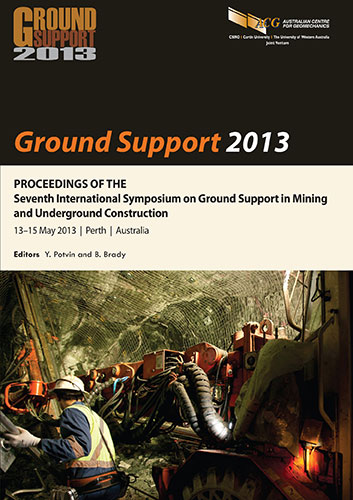Evaluation of Australian cement reactivity in accelerated shotcrete

|
Authors: Boon, G; Kunasagaram, D |
DOI https://doi.org/10.36487/ACG_rep/1304_42_Boon
Cite As:
Boon, G & Kunasagaram, D 2013, 'Evaluation of Australian cement reactivity in accelerated shotcrete', in Y Potvin & B Brady (eds), Ground Support 2013: Proceedings of the Seventh International Symposium on Ground Support in Mining and Underground Construction, Australian Centre for Geomechanics, Perth, pp. 609-616, https://doi.org/10.36487/ACG_rep/1304_42_Boon
Abstract:
Accelerated shotcrete is a common method of ground support used in underground mines in Australia. Sufficient early strength gain relies upon the chemical composition of the shotcrete accelerator and the cement with which it reacts. The chemical composition of Ordinary Portland Cement used in shotcrete application varies significantly throughout Australia. Early strength development after the application of shotcrete is a determining factor for calculating the re-entry time during in-cycle underground mining. Due to the variance in the cement chemistry available in Australia, this article will show the effect of different cement on early strength development. Analysis of the most commonly used cements in Australia will be shown and how they can be classified. An overview of the cement chemistry of Australian cements and the impact of the cement chemistry on the early strength development using a set of standard shotcrete accelerators will be shown. The objective of this paper is to provide inside information to geotechnical engineers on the reaction time difference between different cements and standard shotcrete accelerators. This research is expected to provide greater confidence to geotechnical engineers in trouble shooting shotcrete early strength problems.
References:
DiNioa, T.P. and Sandberg, P.J. (2004) Alkali-free shotcrete accelerator interactions with cement and admixtures, in Proceedings Shotcrete: More Engineering Developments, E.S. Bernard (ed), Second International Conference on Engineering Developments in Shotcrete, 4 October 2004, Cairns, Australia, Taylor & Francis Group.
Gallucci, E. (2013) Cement Analysis, Internal Report, CAS-2012-1426, Sika Technology.
Lootens, D., Pavcnik, L., Srabotic, M. and Oblak, L. (2012) Calorimetry for cement, gypsum, mortar and concrete. Comparison between semi-adiabatic and isothermal calorimetry, Project no. 10.210.1471, Report no. 5072, Internal Report, Sika Technology.
Lootens, D., Bourquin, R. and Kuhn, P. (2010a) Strength development measurements from ultrasonic attenuation, Project no. 08.210.1314, Report no. 4664, Internal Report, Sika Technology.
Lootens, D., Bourquin, R., Kuhn, P. and Oblak, O. (2010b) Scaling of shotcrete. Concepts, constructions and results, Project no. 10.210.1471, Report no. 4779, Internal Report, Sika Technology.
Schlumpf, J., Höfler, J. and Jahn, M. (2011) Sika Sprayed Concrete Handbook, Sika Services AG, Putzmeister AG.
© Copyright 2025, Australian Centre for Geomechanics (ACG), The University of Western Australia. All rights reserved.
View copyright/legal information
Please direct any queries or error reports to repository-acg@uwa.edu.au
View copyright/legal information
Please direct any queries or error reports to repository-acg@uwa.edu.au